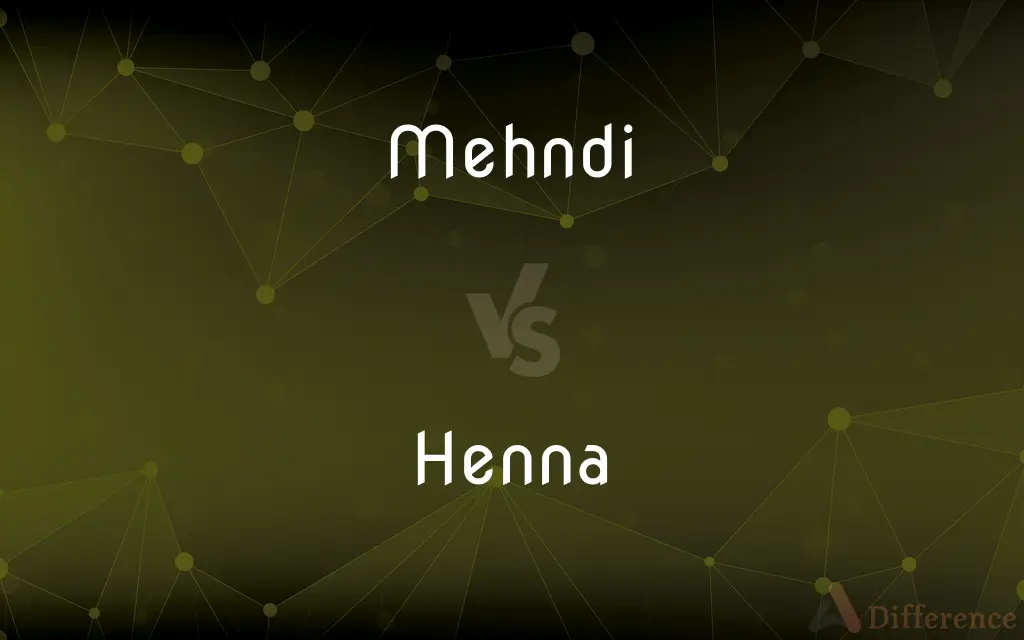Mehndi vs. Henna — What's the Difference?
By Fiza Rafique & Urooj Arif — Updated on April 16, 2024
Mehndi refers to the art of applying henna patterns on the skin, primarily for ceremonial purposes, while henna is the dye prepared from the henna plant used for these designs and hair coloring.

Difference Between Mehndi and Henna
Table of Contents
ADVERTISEMENT
Key Differences
Mehndi is the traditional practice of applying intricate patterns on the skin, especially during celebrations in South Asian cultures, whereas henna is the natural dye extracted from the leaves of the henna plant used in this art. Both are deeply embedded in cultural rituals, but their roles are distinct.
In terms of application, mehndi is a skilled art form that requires precision and creativity, often performed by trained artists, while henna itself can be used by anyone and is also popular for dyeing hair and fabrics, showcasing its versatility beyond body art.
Mehndi designs are usually applied to the hands and feet during special occasions like weddings and religious festivals, emphasizing their role in celebration and ritual, on the other hand, henna as a product is used globally in various forms, including in temporary tattoos and organic hair dyes.
The practice of mehndi is often associated with specific cultural and symbolic significance, believed to bring luck and happiness, whereas henna is appreciated for its natural cooling properties and has been used traditionally for its medicinal benefits.
While mehndi art is temporary, lasting a few weeks at most, the memories and significance of the occasions they mark linger much longer, whereas henna’s staining ability and its temporary nature make it a popular choice for those seeking non-permanent body art options.
ADVERTISEMENT
Comparison Chart
Definition
Art form of applying patterns on skin
Natural dye extracted from henna plant
Primary Use
Body art for cultural and ritual purposes
Dye for skin, hair, and fabrics
Cultural Significance
Deeply rooted in South Asian traditions
Used worldwide in various cultures
Duration on Skin
Lasts 1-3 weeks
Same, depending on application
Associated Celebrations
Weddings, religious festivals
Used more broadly without specific associations
Compare with Definitions
Mehndi
Traditionally used in South Asian weddings and festivals.
During Diwali, many women adorn their hands with mehndi.
Henna
Used for temporary body art as well as hair dyeing.
He chose a henna tattoo of a dragon on his arm.
Mehndi
The art of applying intricate henna designs on the body.
She had beautiful mehndi applied to her arms and legs for her wedding.
Henna
Known for its cooling properties and natural origin.
Applying henna is popular in hot climates for its soothing effect on the skin.
Mehndi
Applied using a cone or brush for precise patterns.
The mehndi artist used a fine-tipped cone to create detailed floral designs.
Henna
Can stain the skin a reddish-brown.
After removing the henna paste, the stain deepened to a rich maroon over two days.
Mehndi
Designs range from simple to elaborate.
Her mehndi design was a complex lattice that wrapped around her wrists and ankles.
Henna
Often mixed with other natural ingredients to alter the color and properties.
She added lemon juice and sugar to her henna paste to improve the stain's intensity.
Mehndi
Considered a symbol of luck and happiness in many cultures.
Mehndi is applied during weddings to bless the bride with good fortune.
Henna
A dye prepared from the crushed leaves of the henna plant.
She mixed henna with tea to enhance its natural red color for her hair.
Mehndi
Mehndi is a form of body art and temporary skin decoration usually drawn on hands or legs, in which decorative designs are created on a person's body, using a paste, created from the powdered dry leaves of the henna plant (Lawsonia inermis). It is a popular form of body art among the women of India, Bangladesh, Pakistan, Nepal, Iran, Maldives, and the Muslim population of Sri Lanka, and resembles similar practices found in North Africa and the Middle East.
Henna
Henna is a dye prepared from the plant Lawsonia inermis, also known as the henna tree, the mignonette tree, and the Egyptian privet, the sole species of the genus Lawsonia. Henna can also refer to the temporary body art resulting from the staining of the skin from the dyes.
Mehndi
The application of henna paste in intricate designs to decorate the body, often for wedding celebrations and other festive occasions in South Asia, the Middle East, and North Africa.
Henna
A tree or shrub (Lawsonia inermis) of the Middle East, having fragrant white or reddish flowers.
Mehndi
Decoration on the body made by mehndi.
Henna
A reddish-brown dyestuff prepared from the dried and ground leaves of this plant, used especially in South and Southwest Asia and North Africa to color leather and fabrics, to dye hair, and to decorate the skin.
Mehndi
Henna substance used for colouring
Henna
A design drawn on the skin with this dyestuff.
Mehndi
Henna the plant
Henna
A moderate or strong reddish brown to strong brown.
Henna
To dye (hair or skin, for example) with henna.
Henna
(countable) A shrub, Lawsonia inermis, having fragrant reddish flowers
Henna
A reddish plant substance, prepared from the dried leaves of this plant, used for temporary tattoos and hair coloring. Hair colorings range from bright red to earth brown to near black.
Henna
A rich reddish-brown colour.
Henna
Of a rich reddish-brown colour.
Henna
(transitive) To dye or tattoo with henna.
Henna
A thorny tree or shrub of the genus Lawsonia (Lawsonia alba). The fragrant white blossoms are used by the Buddhists in religious ceremonies. The powdered leaves furnish a red coloring matter used in the East to stain the nails and fingers, the manes of horses, etc.
Henna
The leaves of the henna plant, or a preparation or dyestuff made from them.
Henna
A reddish brown dye used especially on hair
Henna
Apply henna to one's hair;
She hennas her hair every month
Common Curiosities
Is henna safe to use on the skin and hair?
Natural henna is safe for most people, but it's important to avoid black henna, which can contain harmful additives.
Can mehndi be done with colors other than the traditional reddish-brown?
Traditional mehndi is reddish-brown, but modern variations can include colors through the addition of dyes.
How long does mehndi typically last on the skin?
Mehndi can last from 1 to 3 weeks on the skin, depending on care and skin type.
What are the cultural significances of mehndi in South Asian traditions?
In South Asian cultures, mehndi is believed to bring luck, joy, and beauty to wearers during significant occasions like weddings.
What should one look for when choosing henna for mehndi?
Pure, natural henna with no additives is best for mehndi to ensure the best color and safety.
How do mehndi artists create such intricate designs?
Mehndi artists use tools like cones or brushes to apply henna precisely, relying on skill and experience to create detailed patterns.
Why is mehndi applied during weddings?
Mehndi is thought to represent the bond of matrimony and is a symbol of good luck and health in marriage.
What other natural ingredients are mixed with henna for different results?
Ingredients like coffee, tea, and essential oils are commonly added to henna to enhance color and longevity.
How does one prepare henna paste for mehndi?
Henna paste is typically prepared by mixing powdered henna with a mildly acidic liquid like lemon juice and letting it rest to release the dye.
What is the main difference between mehndi and henna?
Mehndi is the art of applying patterns with henna, which is the natural dye used for creating those patterns.
Are there any health benefits to using henna?
Henna is known for its natural antifungal and antibacterial properties, making it beneficial for skin and scalp health.
Can henna be used on all hair types?
Yes, henna is versatile and can be used on all hair types, offering a natural dyeing option.
Is there a way to make mehndi designs last longer?
Caring for mehndi by avoiding water contact and applying oils can help prolong the design's visibility.
Can men have mehndi designs applied?
Yes, it is increasingly popular for men in various cultures to have mehndi applied for special occasions.
What happens if someone is allergic to henna?
Those allergic to henna might experience redness, itching, or swelling, and should do a patch test before full application.
Share Your Discovery

Previous Comparison
Trapball vs. Trapstick
Next Comparison
Ep vs. LpAuthor Spotlight
Written by
Fiza RafiqueFiza Rafique is a skilled content writer at AskDifference.com, where she meticulously refines and enhances written pieces. Drawing from her vast editorial expertise, Fiza ensures clarity, accuracy, and precision in every article. Passionate about language, she continually seeks to elevate the quality of content for readers worldwide.
Co-written by
Urooj ArifUrooj is a skilled content writer at Ask Difference, known for her exceptional ability to simplify complex topics into engaging and informative content. With a passion for research and a flair for clear, concise writing, she consistently delivers articles that resonate with our diverse audience.















































